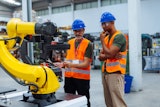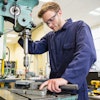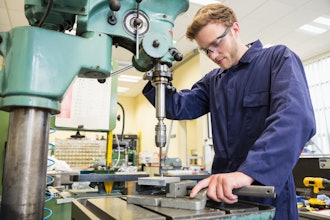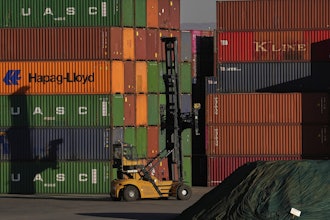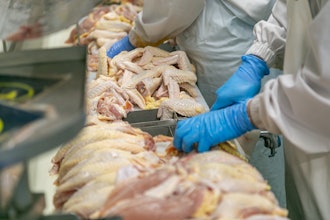Editor's note: This article originally appeared in the November/December 2015 issue of Food Manufacturing
Food Manufacturing had the opportunity to correspond with Chris Murtha, Industry Manager, Yale Materials Handling Corporation, on the topic of material handling and the use of lift trucks in the food manufacturing industry.
Q. Are there any emerging lift truck trends that are especially relevant to food manufacturing operations?
A. The emergence of lithium-ion batteries in particular has great potential for food manufacturing operations. These time-sensitive operations require a high degree of equipment availability, and do not have the advantage of extended charging times or unscheduled repairs and maintenance. A lift truck powered by lithium-ion battery technology addresses these needs by offering several advantages over other power options. Lithium-ion batteries are capable of lasting up to five times longer than traditional lead acid batteries and are maintenance free, meaning they require no watering and contain no acid, a great alternative for food environments. The combined effects of these advantages allow operators to spend more time moving product and less time on charging or maintenance.
ALSO SEE: Effectively Improve Operational Efficiency for Food and Beverage Manufacturers
Food operations should also pay attention to advances in telemetry for improved asset management. Since uptime is such an important factor for food manufacturing operations, telemetry helps set informed, data-driven preventive maintenance schedules and can also provide automated alerts to catch issues before they result in more expensive and time-consuming equipment outages.
Q. Are there particular types of lift trucks that operate best in harsh freezer conditions found in food manufacturing applications? What makes trucks best suited for those temperatures?
A. Electric lift trucks are frequently used for harsh freezer conditions including: counterbalanced electric trucks, reach trucks, order selectors, turret trucks and walkie/rider trucks. These trucks are built to accommodate diverse conditions and offer reduced emissions, which are good for food manufacturing environments. If the environment where the trucks will operation requires frequent truck wash downs, an optional or standard environmental or wash-down package can provide an added layer of protection to equipment. Additionally, one should make sure to choose the right tires for the application, as freezer and cooler areas often have traction problems.
Considering the human component is also important when deciding on a truck. Features like heated handles and floors, and freezer glove compatible controls help keep employees focused on the task at hand, rather than struggling to stay warm.
Q. What challenges do extreme environments like food processing and wash-down applications, present to lift trucks?
Moisture is an important factor to consider in refrigerated and frozen environments, as it poses a threat to electrical components and truck performance. Lift truck designs should account for the risk of moisture in numerous ways, including completely sealing sensitive components and using drip loops to route moisture away from critical components.
Specific packages for wash-down applications are available that include a galvanized frame and lift linkage, and a special corrosion inhibitor on other exposed, unpainted surfaces such as the drive wheel and drive unit. Further precautions include water-tight enclosures for electric brakes, wire harnesses, electric motors and caster wheel bearings.
Q. What are important considerations when selecting a lift truck for a food manufacturing facility?
Look for equipment with the capability to improve productivity in a variety of applications, whether cross docking, load shuttling or order picking. Application specific maneuverability and travel speed are critical features which can reduce travel time on long runs, and ensure smooth travel through tight spaces while maintaining load stability and minimizing potential damage to product and equipment. Automatic speed reduction on cornering, electrical power steering and anti-roll back technology for inclines help ensure efficient operation and maximum uptime.
When making a purchasing decision, also consider the demands of peak season. Battery capacity and ergonomics come into play during multi-shift operation. A large enough battery capacity reduces the frequency of battery charging and can even last for two full shifts. Ergonomics also play a critical role in reducing the impact of operator fatigue. Easy-to-use controls and comfortable features such as padded floors, backrests and picking platforms that raise and lower can enhance operator productivity and reduce fatigue, for consistent performance. Additionally, don’t forget about keeping the operator warm and comfortable. Features like heated handles and floors, and freezer glove compatible controls help keep employees focused on the task at hand, rather than struggling to stay warm.
Q. In what ways can lift trucks improve efficiency at food manufacturing facilities?
A. A lift truck can be an effective tool to enhance labor productivity. The right ergonomic features, such as adjustable backrests, convenient controls and a more comfortable ride help reduce operator fatigue and improve ease of use for more efficient, productive drivers.
Effective management of power sources, such as adhering to proper charging processes and maintaining a proper battery rotation can also enhance efficiency though increased equipment availability, sustained performance, and reduced replacement and maintenance costs.
Additionally, a well-executed telemetry wireless asset management system does so much more than simply monitor a group of data points. It brings together a variety of data insights and produces actionable business intelligence to help improve processes and address smaller issues before they become more costly problems. Whether it’s a low oil level or a transmission heating up, the telematics can alert a maintenance resource remotely, enabling the operator to continue working while ensuring an early warning sign does not go unnoticed.
